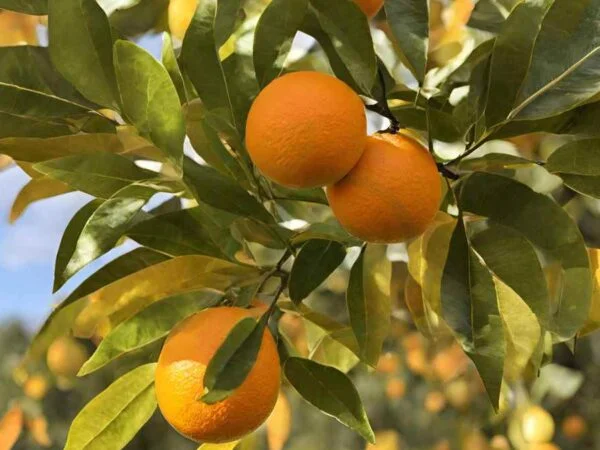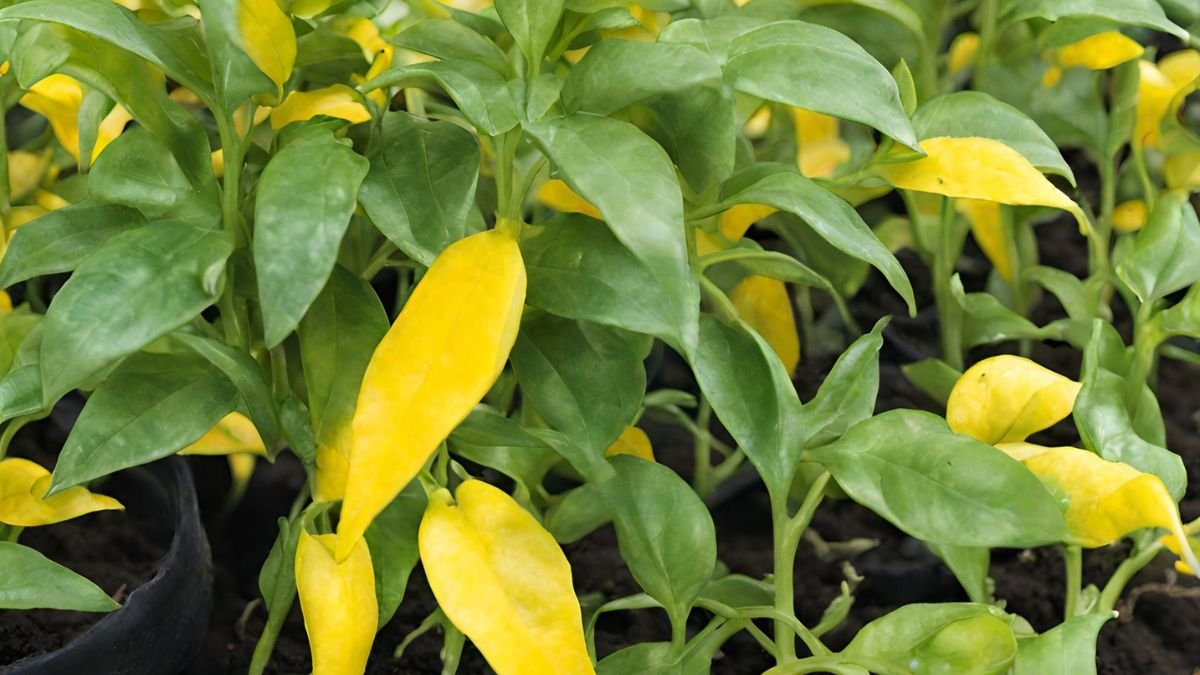
When your pepper seedlings start showing yellow leaves, it can be a sign of various issues affecting their growth such as nutrient deficiency. Identifying the root cause behind this discoloration is crucial to ensure the health and vitality of your plants.
Yellowing leaves in pepper seedlings can be a result of nutrient deficiencies, overwatering, pests, or environmental stressors. By understanding these factors and implementing targeted remedies, you can promote the green and robust growth of your pepper plants. Stay tuned to learn how to revive your yellowing pepper seedlings and foster a thriving garden.
Key Takeaways
- Identify Yellow Leaves: Recognize the signs of yellow leaves on pepper seedlings to address potential issues promptly, such as magnesium deficiency, which could be the cause.
- Address Nitrogen Deficiency: If yellowing is due to nitrogen deficiency, consider using nitrogen-rich fertilizers to restore plant health.
- Check for Other Nutrient Shortages: Monitor for deficiencies in other essential nutrients like potassium and magnesium to maintain plant vitality.
- Optimize Watering Practices: Ensure proper watering by allowing the soil to dry slightly between waterings to prevent overwatering issues.
- Consider Temperature Impact: Be mindful of temperature fluctuations as extreme heat or cold can stress pepper plants, leading to yellowing leaves.
- Choose Suitable Fertilizer Types: Select fertilizers tailored to pepper plant needs, focusing on balanced nutrients for healthy growth.
Identifying Yellow Leaves
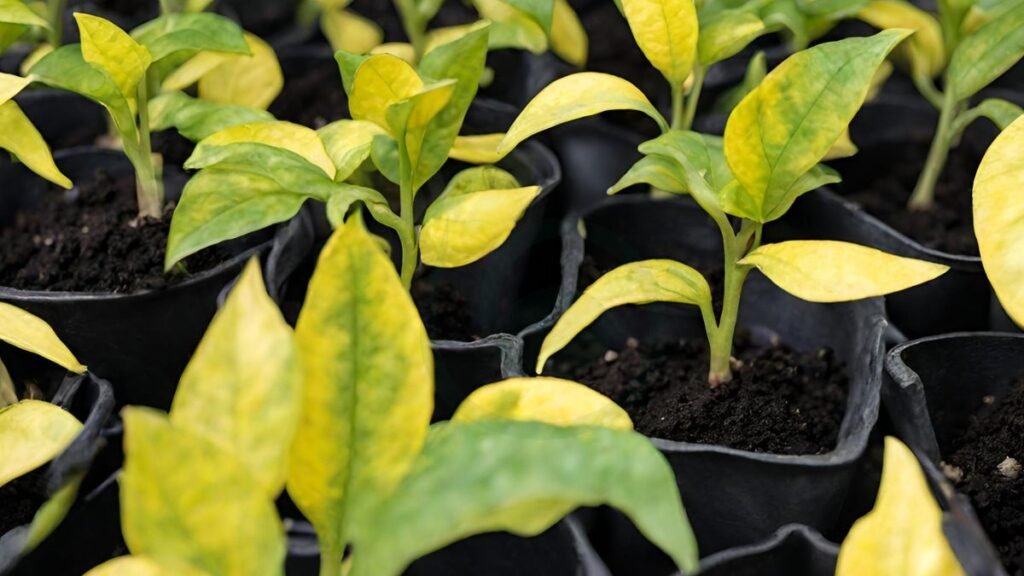
Common Causes
Pepper plants develop yellow leaves due to overwatering, causing root rot and nutrient leaching. Underwatering results in drooping and yellowing leaves due to lack of moisture. Pests like mites can also lead to yellow spots on pepper plant leaves.
- Overwatering: Root rot and nutrient leaching
- Underwatering: Drooping and yellow leaves
- Pests like mites causing yellow spots
Nutrient Deficiencies
The lack of nutrients in the soil can trigger yellowing in pepper plants, affecting growth and fruit production. Feeding the soil with organic fertilizers is vital for replenishing essential nutrients. Using homemade compost is an effective way to address nutrient deficiencies naturally.
- Lack of nutrients affecting growth
- Feeding soil with organic fertilizers
- Homemade compost for natural nutrient replenishment
Water Stress
Water stress impacts pepper plants, leading to wilted and yellow leaves. Maintaining proper watering habits is crucial for plant health and vigor. Watering dry soil helps revive yellowing pepper plants by providing much-needed hydration.
- Wilted and yellow leaves from water stress
- Importance of proper watering habits
- Reviving plants by watering dry soil
Temperature Effects
Cold weather can cause pepper plants to turn yellow, affecting overall health and growth. It is advisable to wait for warmer temperatures before planting peppers outdoors to prevent damage. Bringing container plants indoors during cold spells safeguards them from temperature fluctuations.
- Cold weather impacting plant health
- Waiting for warmer temperatures before planting outdoors
- Bringing container plants indoors during cold spells
Nitrogen Deficiency
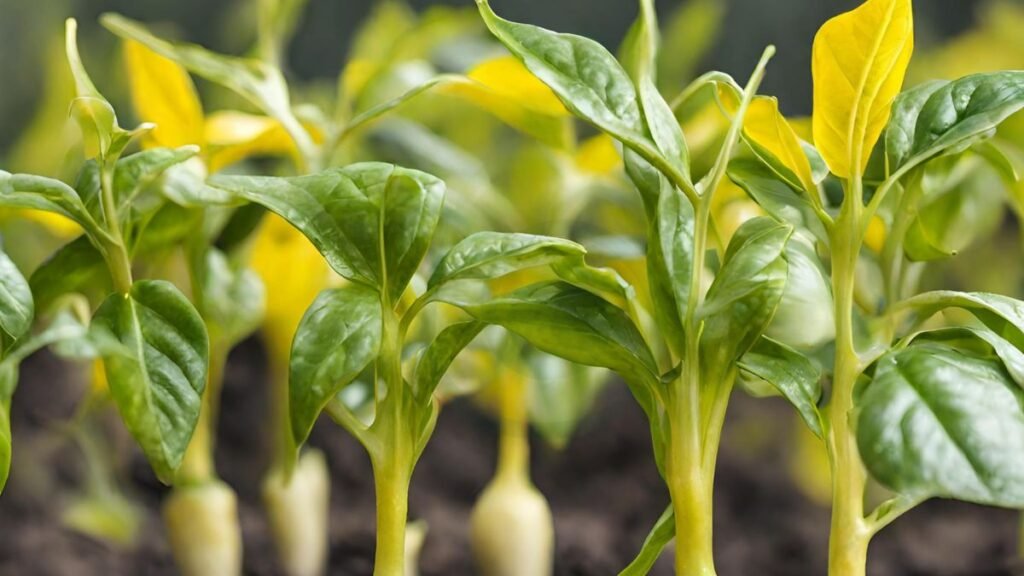
Symptoms
Yellowing of leaves in pepper plants is a common symptom of nitrogen deficiency. The lower leaves typically turn pale green or yellow, starting from the tips and spreading towards the base. In severe cases, the entire plant may exhibit this discoloration.
Overwatering can mimic nitrogen deficiency symptoms by causing yellowing due to root rot. On the other hand, underwatering leads to wilting and eventual yellowing of leaves. To differentiate, check the soil moisture level by inserting a finger into the soil - dry soil indicates underwatering.
Visual cues of nutrient deficiencies in pepper plants include stunted growth, leaf curling, and yellowing of older leaves first. Nitrogen-deficient plants may also have smaller fruit and reduced overall yield.
Solutions
Soil Amendments
Amending soil with compost or well-rotted manure boosts nutrient levels and improves soil structure for healthy pepper plants. The benefits include enhanced water retention, increased microbial activity, and better nutrient absorption by roots.
Adding organic matter like compost enriches the soil with essential nutrients over time. This process enhances soil fertility, promotes beneficial microorganisms, and aids in maintaining optimal pH levels for plant growth.
l amendments play a crucial role in preventing yellow leaves in pepper seedlings by providing a balanced nutrient environment for robust plant development. They ensure that essential elements like nitrogen are readily available for uptake by the roots.
Fertilizer Choices
Organic fertilizers offer slow-release nutrients that benefit plants over an extended period without risk of burning roots. Synthetic fertilizers provide quick nutrition but may require more frequent applications.
Choosing the right fertilizer is vital for plant health as it directly impacts growth, flowering, and fruit production. Organic options promote long-term soil health and microbial activity compared to synthetic counterparts.
Different fertilizers affect the prevention of yellow leaves differently based on their nutrient composition and release rates. Opt for a balanced fertilizer rich in nitrogen to address deficiencies effectively.
Other Nutrient Shortages
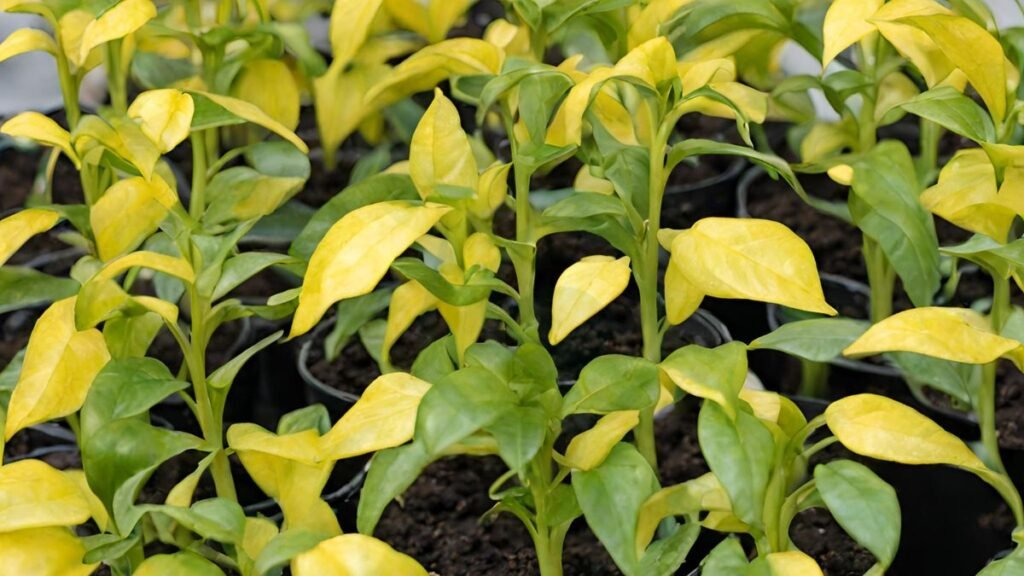
Magnesium Needs
Magnesium plays a crucial role in preventing yellowing in pepper plants by aiding in chlorophyll production. Deficiency of magnesium can result in yellow leaves due to impaired photosynthesis. To ensure pepper plants receive sufficient magnesium, consider applying Epsom salts or magnesium sulfate to the soil as a supplement.
Calcium Requirements
Calcium is essential for maintaining healthy pepper plants as it helps in cell wall formation and nutrient uptake. Insufficient calcium can lead to yellowing of pepper leaves, affecting overall plant health. To meet the calcium needs of pepper seedlings, add lime to the soil or use calcium-fortified fertilizers for optimal growth.
Watering Practices
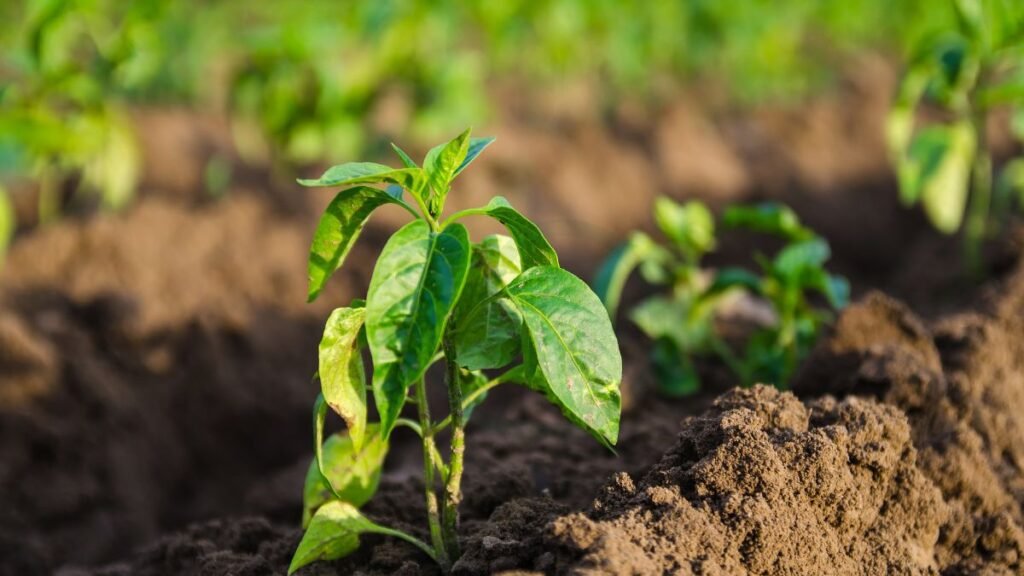
Overwatering Issues
Overwatering negatively affects pepper plants by causing root rot and yellow leaves due to lack of oxygen. To avoid overwatering, ensure proper drainage in pots and water only when the top inch of soil is dry. Excess moisture impairs root health, leading to stunted growth and nutrient deficiencies.
Underwatering Signs
Signs of underwatering in pepper plants include wilting, curling leaves, and dry, crispy edges. Underwatering can result in yellowing and drooping leaves as the plant struggles to absorb nutrients. Adjust watering practices by increasing frequency based on soil dryness to prevent yellow leaves.
Temperature Impact
Cold Weather Survival
Pepper plants can struggle in cold weather, leading to yellow leaves due to temperature stress. To help them survive, consider strategies like covering them with cloches or row covers. Low temperatures can shock pepper plants, causing their leaves to turn yellow as a sign of distress. Protect seedlings by bringing them indoors or using mulch for insulation against the cold.
Heat Stress Prevention
Heat stress can harm pepper plants, resulting in yellow leaves. Prevent this by providing adequate water and ensuring proper ventilation for cooling. Shade is crucial during hot weather to shield plants from excessive heat and prevent leaf discoloration. Maintain optimal conditions to keep pepper seedlings healthy throughout the growing season.
Fertilizer Types
Organic Options
Organic fertilizers offer numerous benefits for growing peppers, promoting healthier plants and soil. They provide essential nutrients naturally, enhancing plant growth and resilience. Utilizing organic methods can improve soil structure, fostering better water retention and nutrient absorption.
Organic pest control methods are advantageous for pepper plants as they avoid harmful chemicals that can affect plant health. Beneficial insects and natural repellents can effectively manage pests without harming the environment or beneficial organisms. This approach promotes a balanced ecosystem in the garden, supporting overall plant health.
For preventing yellow leaves on pepper seedlings, organic fertilizers are highly recommended. Organic fertilizers release nutrients slowly, ensuring a steady supply for the plants without causing nutrient imbalances. Examples include compost, manure, and fish emulsion, providing a rich source of nutrients for healthy pepper growth.
Synthetic Solutions
Synthetic fertilizers play a crucial role in addressing specific nutrient deficiencies in pepper plants efficiently. They provide concentrated doses of essential nutrients, quickly correcting any deficiencies to support plant growth. Synthetic solutions are easily absorbed by plants, ensuring rapid uptake for immediate benefits.
In combating yellowing in pepper plants, synthetic solutions can be highly effective due to their precise nutrient composition. They deliver targeted nutrients to address specific deficiencies that cause yellow leaves, promoting greener and healthier foliage. Synthetic fertilizers offer a quick fix for nutrient issues to revive struggling pepper seedlings.
Synthetic pest control methods can effectively manage pests on pepper seedlings, offering quick and reliable solutions to protect plant health. Pesticides formulated with synthetic ingredients can target pests directly while minimizing harm to beneficial insects. This approach provides immediate relief from pest infestations to safeguard young pepper plants.
Soil Health Improvement
pH Balancing
Maintaining the right pH balance is crucial for healthy pepper plants as it influences nutrient absorption. Imbalanced pH levels can lead to deficiencies and result in yellow leaves. To prevent this, consider testing soil pH and adjusting it to the optimal range for peppers. Incorporate lime to raise pH or sulfur to lower it, ensuring a balanced environment.
Adding the correct amount of organic matter enhances soil fertility and structure, benefiting pepper plants. Organic matter aids in retaining moisture, improving drainage, and fostering beneficial soil organisms. Consider incorporating compost, manure, or cover crops into the soil to boost its organic content. This practice promotes long-term soil health and supports robust plant growth.
Organic Matter Addition
The addition of organic matter into the soil offers numerous benefits for pepper plants. It helps in improving soil structure by enhancing aeration and water retention capacity. Furthermore, organic matter provides essential nutrients gradually over time, supporting sustained plant growth without causing nutrient imbalances. By increasing organic matter levels, you create a thriving environment for healthy pepper seedlings.
Plant Care Tips
Pruning Techniques
Pruning is essential for healthy pepper plants as it promotes growth and prevents disease. By trimming excess foliage, airflow improves, reducing the risk of yellow leaves. Proper pruning techniques involve removing dead or damaged branches to encourage new growth.
Regularly monitoring pepper plant growth is crucial for early detection of issues like yellowing leaves. Observation helps in identifying nutrient deficiencies or pest infestations that may lead to discoloration. Understanding the plant's growth patterns aids in addressing any problems promptly.
Monitoring Growth
To maintain healthy pepper plants, gardeners should monitor growth consistently. Yellowing leaves can be a sign of overwatering, nutrient deficiencies, or inadequate sunlight. By observing changes in leaf color and size, gardeners can take corrective actions to ensure plant vitality.
Observing the development of flowers on pepper plants is vital for assessing their overall health. Healthy flowering indicates proper nutrition and care, while a lack of flowers may signal underlying issues. Regularly checking flower production helps in adjusting watering and fertilization practices accordingly.
Preventive Measures
Pest Control
Pests can cause yellowing of pepper plant leaves, impacting growth and yield. Strategies like introducing beneficial insects can help control mites and aphids effectively. Regularly inspecting plants is crucial for early pest detection.
- Pros: Natural pest control methods are eco-friendly and safe for plants.
- Cons: Chemical pesticides can harm beneficial insects and the environment.
Disease Prevention
Diseases are a significant threat to pepper plants, leading to yellow leaves. Common diseases include bacterial leaf spot and powdery mildew. Proper watering, spacing, and ventilation are essential for disease prevention.
- Ensure good air circulation around plants.
- Avoid overhead watering to prevent fungal diseases.
Closing Thoughts
By understanding the signs of nutrient deficiencies, adjusting watering practices, and improving soil health, you can effectively address yellow leaves on your pepper seedlings. Remember to provide the right nutrients, maintain proper watering levels, and ensure optimal growing conditions to support healthy plant growth. Implementing these plant care tips and preventive measures will help your pepper seedlings thrive and produce bountiful yields.
Take action today by applying these strategies to revive your pepper seedlings and promote a flourishing garden. With the right knowledge and proactive steps, you can enjoy a vibrant and productive pepper harvest. Stay attentive to your plants' needs, and watch as they flourish under your care.
Frequently Asked Questions
What causes yellow leaves on pepper seedlings?
Yellow leaves on pepper seedlings can be caused by various factors such as nitrogen deficiency, other nutrient shortages, improper watering practices, extreme temperatures, or soil health issues.
How can I identify the cause of yellow leaves on my pepper seedlings?
To identify the cause of yellow leaves on your pepper seedlings, observe closely for signs of nutrient deficiencies like yellowing patterns, check watering practices and soil moisture levels, assess temperature conditions, and review fertilizer types used.
What are some preventive measures to avoid yellow leaves on pepper seedlings?
Prevent yellow leaves by maintaining proper watering practices, ensuring adequate nutrition through balanced fertilization, monitoring temperature fluctuations, improving soil health with organic matter, and regularly inspecting plants for early signs of stress.
Is nitrogen deficiency a common reason for yellow leaves in pepper seedlings?
Yes, nitrogen deficiency is a common reason for yellow leaves in pepper seedlings. Symptoms include overall leaf yellowing starting from older leaves first. To address this issue, consider using a balanced fertilizer containing nitrogen to promote healthy plant growth.
How can I improve the soil health for my pepper seedlings to prevent yellow leaves?
Improve soil health by adding organic matter like compost or well-rotted manure to enhance nutrient availability and water retention. Conduct soil tests periodically to monitor pH levels and nutrient content, ensuring an optimal growing environment for healthy pepper plants.
Image Source: Paid image from CANVA



